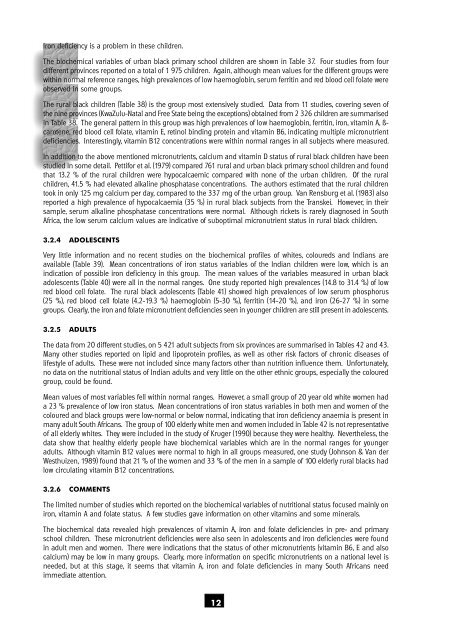the nutritional status of - Health Systems Trust
the nutritional status of - Health Systems Trust
the nutritional status of - Health Systems Trust
You also want an ePaper? Increase the reach of your titles
YUMPU automatically turns print PDFs into web optimized ePapers that Google loves.
iron deficiency is a problem in <strong>the</strong>se children.<br />
The biochemical variables <strong>of</strong> urban black primary school children are shown in Table 37. Four studies from four<br />
different provinces reported on a total <strong>of</strong> 1 975 children. Again, although mean values for <strong>the</strong> different groups were<br />
within normal reference ranges, high prevalences <strong>of</strong> low haemoglobin, serum ferritin and red blood cell folate were<br />
observed in some groups.<br />
The rural black children (Table 38) is <strong>the</strong> group most extensively studied. Data from 11 studies, covering seven <strong>of</strong><br />
<strong>the</strong> nine provinces (KwaZulu-Natal and Free State being <strong>the</strong> exceptions) obtained from 2 326 children are summarised<br />
in Table 38. The general pattern in this group was high prevalences <strong>of</strong> low haemoglobin, ferritin, iron, vitamin A, ß-<br />
carotene, red blood cell folate, vitamin E, retinol binding protein and vitamin B6, indicating multiple micronutrient<br />
deficiencies. Interestingly, vitamin B12 concentrations were within normal ranges in all subjects where measured.<br />
In addition to <strong>the</strong> above mentioned micronutrients, calcium and vitamin D <strong>status</strong> <strong>of</strong> rural black children have been<br />
studied in some detail. Pettifor et al. (1979) compared 761 rural and urban black primary school children and found<br />
that 13.2 % <strong>of</strong> <strong>the</strong> rural children were hypocalcaemic compared with none <strong>of</strong> <strong>the</strong> urban children. Of <strong>the</strong> rural<br />
children, 41.5 % had elevated alkaline phosphatase concentrations. The authors estimated that <strong>the</strong> rural children<br />
took in only 125 mg calcium per day, compared to <strong>the</strong> 337 mg <strong>of</strong> <strong>the</strong> urban group. Van Rensburg et al. (1983) also<br />
reported a high prevalence <strong>of</strong> hypocalcaemia (35 %) in rural black subjects from <strong>the</strong> Transkei. However, in <strong>the</strong>ir<br />
sample, serum alkaline phosphatase concentrations were normal. Although rickets is rarely diagnosed in South<br />
Africa, <strong>the</strong> low serum calcium values are indicative <strong>of</strong> suboptimal micronutrient <strong>status</strong> in rural black children.<br />
3.2.4 ADOLESCENTS<br />
Very little information and no recent studies on <strong>the</strong> biochemical pr<strong>of</strong>iles <strong>of</strong> whites, coloureds and Indians are<br />
available (Table 39). Mean concentrations <strong>of</strong> iron <strong>status</strong> variables <strong>of</strong> <strong>the</strong> Indian children were low, which is an<br />
indication <strong>of</strong> possible iron deficiency in this group. The mean values <strong>of</strong> <strong>the</strong> variables measured in urban black<br />
adolescents (Table 40) were all in <strong>the</strong> normal ranges. One study reported high prevalences (14.8 to 31.4 %) <strong>of</strong> low<br />
red blood cell folate. The rural black adolescents (Table 41) showed high prevalences <strong>of</strong> low serum phosphorus<br />
(25 %), red blood cell folate (4.2-19.3 %) haemoglobin (5-30 %), ferritin (14-20 %), and iron (26-27 %) in some<br />
groups. Clearly, <strong>the</strong> iron and folate micronutrient deficiencies seen in younger children are still present in adolescents.<br />
3.2.5 ADULTS<br />
The data from 20 different studies, on 5 421 adult subjects from six provinces are summarised in Tables 42 and 43.<br />
Many o<strong>the</strong>r studies reported on lipid and lipoprotein pr<strong>of</strong>iles, as well as o<strong>the</strong>r risk factors <strong>of</strong> chronic diseases <strong>of</strong><br />
lifestyle <strong>of</strong> adults. These were not included since many factors o<strong>the</strong>r than nutrition influence <strong>the</strong>m. Unfortunately,<br />
no data on <strong>the</strong> <strong>nutritional</strong> <strong>status</strong> <strong>of</strong> Indian adults and very little on <strong>the</strong> o<strong>the</strong>r ethnic groups, especially <strong>the</strong> coloured<br />
group, could be found.<br />
Mean values <strong>of</strong> most variables fell within normal ranges. However, a small group <strong>of</strong> 20 year old white women had<br />
a 23 % prevalence <strong>of</strong> low iron <strong>status</strong>. Mean concentrations <strong>of</strong> iron <strong>status</strong> variables in both men and women <strong>of</strong> <strong>the</strong><br />
coloured and black groups were low-normal or below normal, indicating that iron deficiency anaemia is present in<br />
many adult South Africans. The group <strong>of</strong> 100 elderly white men and women included in Table 42 is not representative<br />
<strong>of</strong> all elderly whites. They were included in <strong>the</strong> study <strong>of</strong> Kruger (1990) because <strong>the</strong>y were healthy. Never<strong>the</strong>less, <strong>the</strong><br />
data show that healthy elderly people have biochemical variables which are in <strong>the</strong> normal ranges for younger<br />
adults. Although vitamin B12 values were normal to high in all groups measured, one study (Johnson & Van der<br />
Westhuizen, 1989) found that 21 % <strong>of</strong> <strong>the</strong> women and 33 % <strong>of</strong> <strong>the</strong> men in a sample <strong>of</strong> 100 elderly rural blacks had<br />
low circulating vitamin B12 concentrations.<br />
3.2.6 COMMENTS<br />
The limited number <strong>of</strong> studies which reported on <strong>the</strong> biochemical variables <strong>of</strong> <strong>nutritional</strong> <strong>status</strong> focused mainly on<br />
iron, vitamin A and folate <strong>status</strong>. A few studies gave information on o<strong>the</strong>r vitamins and some minerals.<br />
The biochemical data revealed high prevalences <strong>of</strong> vitamin A, iron and folate deficiencies in pre- and primary<br />
school children. These micronutrient deficiencies were also seen in adolescents and iron deficiencies were found<br />
in adult men and women. There were indications that <strong>the</strong> <strong>status</strong> <strong>of</strong> o<strong>the</strong>r micronutrients (vitamin B6, E and also<br />
calcium) may be low in many groups. Clearly, more information on specific micronutrients on a national level is<br />
needed, but at this stage, it seems that vitamin A, iron and folate deficiencies in many South Africans need<br />
immediate attention.<br />
12
















